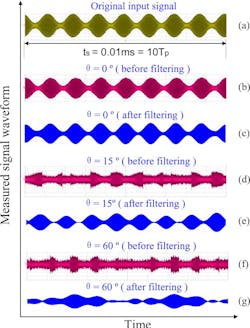4D Antennas Secure Wireless Communications
This file type includes high resolution graphics and schematics when applicable.
Even in highly directional antenna arrays, side-lobe radiations exist. These radiations can be received by highly sensitive antenna systems. Creating antenna arrays without side lobes is difficult, as systematic and random errors in antenna arrays induce stray radiation. To disable eavesdropping and enhance wireless-communications security, an antenna-array technique using time modulation has been developed by Quanjiang Zhu, Shiwen Yang, Ruilin Yao, and Zaiping Nie of the University of Electronic Science and Technology of China.
The group uses a switching technique that doesn’t compromise the directivity of the antenna. Several of the outer elements of the antenna array are switched from on and off states in alternating patterns. This approach induces time modulation for the signal transmission from the side lobes. Yet it does not influence the primary lobe. The aliasing effects of time modulation manipulate the side-lobe signals so that they are indecipherable.
As long as the signal bandwidth is greater than the time-modulated frequency, the primary lobe signal can be restored using simple filtering. A LeCroy oscilloscope was used in the testing of an AM-based test to distort time modulation. The results demonstrated significant distortion of the AM signal from the side lobes and a restored AM signal after filtering out the side-lobe signals (see figure).
A simulated test of a BPSK was also performed. It demonstrated a recoverable primary signal with distorted side lobes. In a bit-error-rate (BER) simulation using the binary-phase-shift-keying (BPSK) signal method, the BER is found to be consistently low at the primary lobe and consistently high at the side-lobes. See “Directional Modulation Based on 4-D Antenna Arrays,” IEEE Transactions on Antennas and Propagation, Feb. 2014, p. 621.
This file type includes high resolution graphics and schematics when applicable.
About the Author
Jean-Jacques DeLisle
Jean-Jacques graduated from the Rochester Institute of Technology, where he completed his Master of Science in Electrical Engineering. In his studies, Jean-Jacques focused on Control Systems Design, Mixed-Signal IC Design, and RF Design. His research focus was in smart-sensor platform design for RF connector applications for the telecommunications industry. During his research, Jean-Jacques developed a passion for the field of RF/microwaves and expanded his knowledge by doing R&D for the telecommunications industry.


